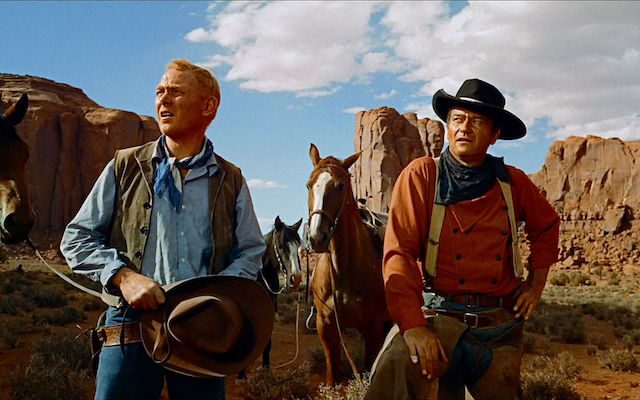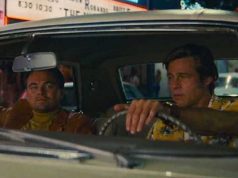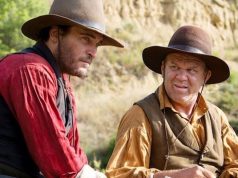
“A rip-snorting Western, as brashly entertaining as they come.” So said New York Times film critic Bosley Crowther in his May 31, 1956, review of The Searchers. His estimation of the amount of snort being ripped was generally shared by critics and audiences, and the film was a modest success in its day. It didn’t get any Academy Award nominations, though, and wasn’t anything like an “instant classic.” Its stock began to rise about 15 years later, when up-and-coming filmmakers started referring to it in their work. It was suddenly #18 on Sight & Sound magazine’s 1972 list of the best films ever made, having been overlooked entirely in the 1962 poll. (It cracked the top 10 in the 1982 poll, and by 1992 had reached the #5 spot.) In short, it grew on people over time. So why did that happen? What’s the big deal with The Searchers? The bigness of the deal is exactly what we are considering today.
The praise:
The American Film Institute put The Searchers at the very top of its list of the greatest Westerns, and #12 on its list of the 100 best American films of any kind. In 1989, the U.S. Library of Congress selected it for preservation in the National Film Registry, an honor bestowed so far on only about 350 feature films.
The context:
Released in the spring of 1956, the film came at the tail end of director John Ford’s extraordinarily prolific career. He’d made more than 100 films already and had won four Best Director Oscars (a record that still stands), and he’d had huge hits with Stagecoach (1939), The Grapes of Wrath (1940), and How Green Was My Valley, among others. Twenty of his previous pictures, like this one, had been Westerns starring John Wayne; Ford and Wayne were the Scorsese and De Niro (or, if you prefer, the Apatow and Rogen) of their day. In fact, many of the actors and technicians involved in the production were regular Ford collaborators, and he shot the film in Utah’s famed Monument Valley, a place he’d frequently worked in the past. The Searchers was a pretty safe bet, in other words.
But while Ford was closely associated with horse operas, The Searchers was the only Western he would make in the 1950s. The genre was fading in popularity at the movies just as the TV Western (led by Gunsmoke, which premiered in September 1955) was starting to take its place. Nonetheless, The Searchers was a box-office hit, the 11th highest-grossing film of the year.
The movie:
Based on a novel by Alan Le May that was loosely inspired by real events, the film is set in Texas in the late 1860s and early 1870s. Ethan Edwards (John Wayne), who fought for the Confederacy and then disappeared for a few years after the war ended, teams up with his adopted nephew, Martin (Jeffrey Hunter), to search for two nieces taken captive by Comanche Indians.
Those are the basics. More specifically (but still avoiding spoilers for first-time viewers), the story is complicated by several factors. Ethan is an unrepentant racist with a particular hatred for Comanches. The fact that Martin is one-eighth Cherokee creates a wedge between them, as do Ethan’s views on the mixing of races. If it turns out the girls have been taken as wives by the Comanches, Ethan will consider them tainted, like a good pie befouled with Drano. A pie like that can’t be “rescued”….
What it influenced:
A 1979 article in New York magazine said that “you could construct half the syllabus for a course on contemporary American cinema just from films that, consciously or not, have been influenced by The Searchers.” The 1970s were a rich period for this. Paul Schrader’s screenplay for Taxi Driver (1976) has elements of it (wanting to protect a young girl from corrupting influences; De Niro even calls Harvey Keitel’s pimp character “chief”), and Schrader’s own film, Hardcore (1979), was based on it, as he freely admitted in interviews. The biggest directors of the decade — Martin Scorsese, Steven Spielberg, George Lucas, Michael Cimino, John Milius — referred to it in their films. Scorsese even included a clip from it in Mean Streets (1973).
When Luke Skywalker returns to his aunt and uncle’s home to find it burned to the ground, anyone who has seen The Searchers will instantly recognize the scenario. (Lucas referenced The Searchers again in Attack of the Clones, when Anakin Skywalker sneaks into the camp where his mother is being held.) Milius, who made The Wind and the Lion (1975) and Big Wednesday (and later Conan the Barbarian, 1982), told New York magazine he’d seen the film 60 times and named his son Ethan after Wayne’s character. “I steal from Ford and I don’t care!” he said. “There has been a reference to The Searchers in all … the movies I’ve directed.”
Films as diverse as Shanghai Noon (2000) and O Brother, Where Art Thou? (2000) borrowed plot elements, the latter in the instance of the weaselly man who is Holly Hunter’s “bona fide” suitor, closely paralleling the goofy fellow who tries to marry Martin’s girlfriend while Martin is away. Ron Howard frequently mentioned in interviews that his 2003 film The Missing was essentially a remake of The Searchers, with Tommy Lee Jones in the John Wayne role.
There’s a musical connection, too. According to John Goldrosen’s biography of Buddy Holly, the singer’s hit “That’ll Be the Day” came directly from John Wayne’s catchphrase in the film.
What to look for:
Ford doesn’t use many close-ups, so when he does, it’s for a reason, usually to underscore an emotion or to emphasize the importance of what’s being said.
Ford often frames the characters in doorways, cave entrances, between the walls of canyons, etc. Note that the film’s very first shot, of a doorway looking out into the world, mirrors the very last shot, and has several echoes in between. Ford was a no-nonsense guy who didn’t like to talk about what his films “meant,” but if nothing else the symmetry of his uncluttered shot compositions are pleasing to look at. The doorway imagery was referenced in House of Sand and Fog (2003) and Quentin Tarantino’s Kill Bill: Vol. 2 (2004) and Inglourious Basterds (2009), among other places.
Many viewers believe that Edward and his brother’s wife, Martha (Dorothy Jordan), are in love with each other. There is ample evidence to support this in the film — and yet not a single line of dialogue addresses it. Watch for the way they regard one another in their few scenes together, and notice the way Martha handles Edward’s coat when she thinks no one is watching. Notice also how the man who is watching pretends not to. It’s all very subtle, but it’s there.
Edward’s character is more complicated than most of the roles Wayne played in his career. His racism toward the Indians is obvious — but notice also how he knows a lot about their culture and customs and is in many ways similar to them (nomadic, uncomfortable in “modern” society, etc.). If this were a film class, you’d probably be asked to write an essay on what this dichotomy tells us about Edward. So, you know, be glad this isn’t a film class.
You might be disappointed in a subplot involving Martin’s fiancee back home, Laurie (Vera Miles), and a goofy suitor, Charlie (Ken Curtis), who tries to steal her away. Peter Bogdanovich’s commentary on the 50th anniversary DVD praises these elements as exemplary of Ford’s ability to inject humor into an otherwise serious movie, but I think that’s a stretch, given that the humor isn’t funny. (Maybe it was in 1956.) Roger Ebert’s essay on the film is a little more realistic: “The film … involves the silly romantic subplot and characters hauled in for comic relief, including the Swedish neighbor Lars Jorgensen (John Qualen), who uses a vaudeville accent, and Mose Harper (Hank Worden), a half-wit treated like a mascot…. This … is without interest, and those who value The Searchers filter it out, patiently waiting for a return to the main story line.” I endorse the Ebert view.
What’s the big deal?
While audiences in 1956 generally saw it as a good, solid Western and nothing more, over time people began to appreciate the film’s deeper themes. It is the rare Western that actually addresses the anti-Indian racism that constitutes such a large part of the Western mythology, and it was not common for the heroic John Wayne to play such a flawed, bigoted character. Some of the ideas the film brings up — racism, miscegenation — are much more alarming than what you’d find in a normal Western. It’s so beautifully shot, too, with the widescreen views of those gorgeous Southwestern landscapes. You can fake that sort of thing nowadays with CGI, but you couldn’t in 1956.
Further reading:
(These are all geared toward people who have seen the movie — i.e., they’re full of spoilers — so wait until after you’ve watched it.)
“‘The Searchers’: Cult Movie of the New Hollywood,” by Stuart Byron, New York magazine, March 5, 1979.
Roger Ebert’s “Great Movies” essay, 2001.
D.K. Holm’s review of the 2006 DVD release.
— Film.com



